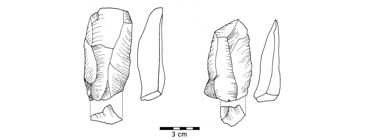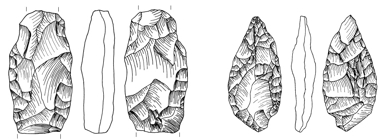The Palaeolithic Component
In addition to Levallois and discoid cores, the scatter contains scores of Levallois and discoid core products (flakes, blades and points), and many of these are retouched (Fig. 20). The scatter also contains a number of other retouched pieces, most distinctive among which are pieces datable to the Middle Palaeolithic, such as side-scrapers and notched flakes. A handful of bifacially worked “leaf points” probably belong to the late part of the period (after 100 k BP) as well, or to the early phases of the Upper Palaeolithic (Fig. 21).
In short, the Middle Palaeolithic at Vrahos is represented not only by refuse from quarrying (cores and waste flakes) but also by tools useful in a range of tasks besides quarrying. From this we conclude that, when they visited Vrahos, folks some times stayed around the hill longer than it took them to provide themselves with a good core and/or a few blanks.
What of the later periods? The situation was reversed. The evidence for use of the quarry in the Upper Palaeolithic is ambiguous, and, for the part of the period after 31 k years BC (cal), essentially absent. While many of the prismatic blade cores and the occasional bladelet core from the scatter might belong to the Upper Palaeolithic, they can just as well be later. Besides, missing entirely are the backed elements characteristic of the Gravettian and later phases of the Upper Palaeolithic.
Vrahos silex was again extensively quarried in later prehistory (Neolithic and Early Bonze Age). The raw material left the site in the forms both of partly prepared cores and blanks (see section Our work in Petrota). But the complete absence of pottery and the extreme rarity of stone tools attributable to these periods militate against everything except brief visits to the site.

